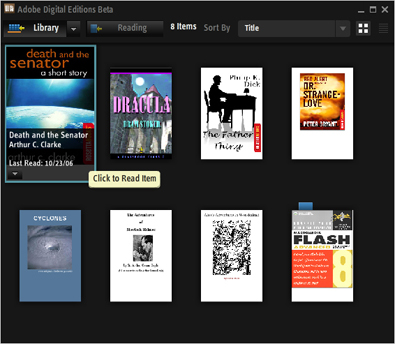Adobe Digital Editions - a new publishing platform

I wrote recently about the New York Times Reader and how I thought it was one of the best examples of Rich Internet Applications out there. Luckily, I don't think I was the only one impressed with the New York Times Reader because Adobe has announced a similar, if more broad initiative in their new Adobe Digital Editions application. Digital editions aims to give publishers a richer gateway into the technology world with technology that allows for DRM and offline/online synching. The press release is here.

The new Digital Editions application has a lot of interesting concepts. It is built on a combination of Flex and Acrobat technology which means it is leveraging the strengths of Adobe's print and readability experience and the newly acquired Flash platform for interactivity. In fact, this is one of the first applications that showcases how powerful the Adobe-Macromedia partnership can be and what users can expect from it.
In order to check out digital editions, you will need to download a free piece of software. For me, the install was as painless as it could be. It's a small download (2.5 megs), and the installer runs through the flash client meaning that it's a seamless experience. Downloading digital content was also quick and painless. The Digital Editions reader associates itself with .etd files and any time you click on one (there are a bunch of examples on Adobe Labs) it opens up Digital Editions and adds the content to your library. There are two book formats available, Adobe PDF and regular XHTML. I couldn't tell the difference between the two formats, but the XHTML version seemed to load just a tad faster. My hunch is that the PDF version will provide a richer experience with improved fonts and better graphics integration. The team that created Digital Editions paid a lot of attention to readability, and the usability of the application is elegant and straight forward.
This is going to be extremely compelling for both content providers and users on a number of fronts. It's exactly the kind of next generation Rich Internet Application I hope we see more of from Adobe. First off, because it is built on Flash and PDF technology, it will be easy to make cross-platform (I believe a Mac OSX beta is planned shortly). Essentially, Adobe has created a platform for digital publishing. Content providers will be able to deliver content in a very new way. The idea of porting digital editions to mobile devices is not far fetched, and as a result, content providers get a lot of reach right out of the gate.
Users have been slow to take to eReader solutions, but I think technologies like the New York Times reader and Digital Editions are going to change that. What makes Digital Editions much different is that it plans to encompass all types of media. Right now there are a series of eBooks available, but this platform could be used by magazines and newspapers to give users access to content. Adobe has also integrated some aspects of LiveCycle policy server, which means that content providers will have an avenue to sell content to users in a way that is unobtrusive and easy to use. Being able to synch your library and bring it with you is what makes this entire thing work, and if publishers feel confident that they can reach users without having content stolen, I think they will buy into this new digital publishing platform from Adobe.
The long term road map for Digital Editions includes some social networking technologies that would allow you to share your reading list with your book club or publish notes you made to specific articles or publications. That is the kind of thing that users will find most interesting. As our lives become more digital, the expectations we have for our content are going to increase. In many ways, the New York Times showed a glimpse of the concept of a "living newspaper" that downloads changes and updates the application in real time. This brings that concept to a wider audience, and I think it does so in a way that users will relate to.